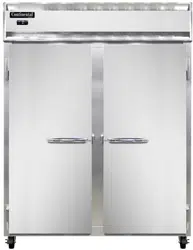Loading ...
Loading ...
Loading ...

14
REACH-INS & ROLL-INS
OPERATIONS MANUAL
DEFROST OPERATION
All freezer models are equipped with an automatic, electric
defrost system, consisting of evaporator coil defrost and drain
pan heater(s). During each defrost period, the condensing unit
and evaporator fans go off, while the defrost heater(s) are ener-
gized. After termination of a defrost cycle, the heaters go off and
the condensing unit turns on. The evaporator fans remain off
(for about 20 minutes) until the coil cools down to a preset tem-
perature (typically 32°F). This defrost drip time, which allows
any remaining water to clear off the evaporator coil, also ensures
that only cold air is circulated throughout the storage compart-
ment. t for the correct time after power is restored, to maintain
the same time of day for defrost.
In some extreme applications, where there is very heavy usage,
excessively high humidity and/or constant door openings, addi-
tional defrost period(s) may be desired to ensure your evapora-
tor remains free of any frost accumulation.
IMPORTANT NOTE: All freezers have a unique, energy
saving defrost cycle, as described above. As explained,
after defrost the automatic fan delay prevents evaporator
fans from operating until the coil has reached a preset
temperature, minimizing warm air circulation in the
cab net. During start-up and after a defrost cycle, fans
will not turn on immediately. Settings should only be
adjusted as noted, to minimize electrical consumption
and provide the most efficient heating cycle. Contact the
factory before making modifications to any settings not
described above. Improper adjustments can cause prob-
lems with your unit, including loss of product and evapo-
rator freeze ups, which are not covered under warranty.
WARMER SYSTEM AND ADJUSTMENT
All Designer Line warming cabinets are designed with an operat-
ing range of 60°F to 180°F and factory performance run tested
to maintain an average cabinet temperature of 150°F. Always
preheat your new warming cabinet to the desired temperature
before placing any food into it. When the desired temperature
is reached and displayed on the electronic control, preheating is
complete and the cabinet is ready to be loaded. Please note that
setting the electronic control higher than the desired tempera-
ture will not provide quicker preheat warm-ups.
Warming cabinets are not designed to cook food. All foods
placed in the warming cabinet should be precooked and at, or
above the desired holding temperature. Never place cold or
uncooked foods in the cabinet. It is recommended that hot
The system should run smooth and quietly in accordance
with generally accepted commercial standards. If any unusual
noises are heard, turn the unit off immediately and check for any
obstructions of the condenser or evaporator fans. Fan motors,
fan blades, or fan housings can be jarred out of position through
rough handling in transit or during installation.
OPERATION
All cabinets must be given sufficient time to reach normal oper-
ating temperature before placing any product inside cabinet.
Refrigerators are designed to maintain an ideal cabinet tem-
perature of 38° to 40°F (3.3° to 4.4°C). Approximately 1 hour
of operation is required to reach this temperature. Freezers are
designed to maintain an ideal cabinet temperature of -4° to 0°F
(-20° to -18°C). Approximately 2 hours of operation are required
to reach this temperature.
REFRIGERATION SYSTEM AND ADJUSTMENT
All self-contained refrigerators are designed and factory set to
maintain an average cabinet temperature of 38° to 40°F (3.3° to
4.4°C). The temperature control is accessible from the top of the
electrical console box located on the cabinet top behind the front
grill (see Figure 9, 9A & 9B).
IMPORTANT NOTE: All refrigerators are designed with an
automatic, “off-cycle” defrost system which means that
defrosting occurs automatically when the compressor is
not operating during an off-cycle. Do not set the electron-
ic control too cold where the cabinet temperature will fall
below 35°F because the evaporator will become blocked
by ice since the compressor off-cycle will be considerably
shortened. This will result in loss of food stored within
the cabinet and require service to defrost the evaporator.
FREEZER SYSTEM AND ADJUSTMENT
All self-contained freezers are factory set to maintain an average
cabinet temperature of -4° to 0°F (-20° to -18°C). These prod-
ucts are designed to hold pre-frozen food and although they are
capable of freezing small quantities of fresh food, they are not to
be used as fast or blast freezers. DO NOT ATTEMPT TO FREEZE
BULK QUANTITIES OF FRESH FOODS.
The temperature control is accessible from the top of the electri-
cal console box located on the cabinet top behind the front grill
(see Figure 9, 9A & 9B).
Loading ...
Loading ...
Loading ...
